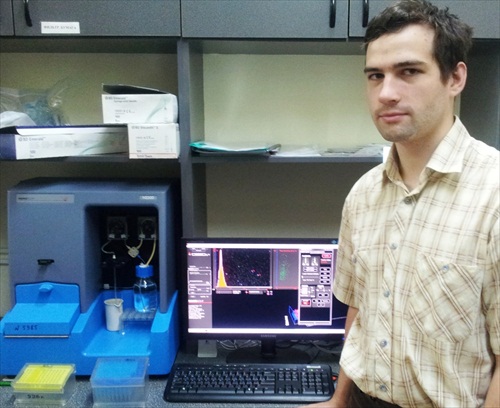Members Login

Channels
Special Offers & Promotions
Lomonosov Moscow State University are using Nanoparticle Tracking Analysis for environmental & biomedical nanoparticle monitoring
NanoSight reports on how Nanoparticle Tracking Analysis, NTA, is used in the work of Dr Ilya Kurochkin of Lomonosov Moscow State University in the development of new bioanalytical systems for environmental and biomedical monitoring
Ilya Kurochkin is Professor and Head of the Laboratory of Postgenomic Chemistry in the Department of Chemistry at the Lomonsov Moscow State University. His research requires characterization of size distribution, concentration and to identify the presence of certain epitopes in two areas: exosomes for the prediction of adverse outcomes in patients with chronic heart failure and for the characterization of gold, silver and metal oxide nanoparticles in the development of new electrochemical biosensors and nanobioanalytical systems based on nanoplasmonic structures.
The study of exosomes is central to the research program. The term "exosome" refers to vesicles generated by exocytosis of multivesicular bodies. Exosomes are 20 - 100 nm in diameter and can be found in the amniotic fluid, blood, breast milk, and urine. Key mechanisms by which exosomes may exert their biological functions on cells include (1) direct contact between surface molecules of vesicles and cells, (2) endocytosis of vesicles, and (3) vesicle-cell membrane fusion. Exosomes may horizontally transfer mRNA and miRNA. Horizontal transfer of oncogenic receptor and transfer of HIV particles have been demonstrated in the case of exosomes. Examples for key functions of exosomes include antigen presentation and immunostimulatory and inhibitory activities.
Exosomes can carry valuable information about the pathology of physiological processes in the human body and, in particular, on the development of cardiovascular diseases. Knowledge of the size distribution, protein and polynucleotide (what) of exosomes in some physiological fluid will actually get a sort of human "exosome profile". The features of this "exosomal profile" will open the possibility to analyze details of physiological processes and obtain information about the initial stages of the pathology.
In the research, it is important to be able to make a quick calculation of the number and estimate the size distribution of the exosomes in the biological fluids. The use of plasmonic nanoparticles will allow multiplex analysis of a large number of target proteins in exosomes. These measurements provide information about a specific protein composition of exosomes, and thus make it the basis of a new nanobioanalytical platform - "human exosome profile".
To achieve this, Professor Kurochkin chose Nanoparticle Tracking Analysis, NTA, as his preferred technique as he needed accurate information on the size and number of his nanostructures in the presence of much larger particles. Prior to NTA, he used a combination of techniques including dynamic light scattering (DLS), atomic force microscopy (AFM) and electron microscopy. As he noted, "The main benefit of the NTA is the ability to accurately measure size distribution for nanostructures in the presence of much larger particles directly in test solutions. The fact that the intensity of light scattering is proportional to the particle diameter to the power of 6, DLS (which captures the signal from all the particles in the sample mixture) does not give an accurate measurement of a particle with a small diameter in the presence of particles with a larger diameter. NTA captures the trajectories of individual particles and therefore the ratio of the particle size does not affect the accuracy of the analysis. Thus, the fact that NTA measures each particle separately is very important. I am particularly excited that I can measure my exosomes with specific antigens using fluorescent tags and plasmonic nanomarkers (gold or silver nanoparticles). Using NTA perfectly overcame the earlier experimental problems of my work. Measurements are rapid and by counting particle by particle, I achieved the level of accuracy I was seeking."
To find out about the company and to learn more about particle characterization using NanoSight's unique nanoparticle tracking analysis solutions, visit www.nanosight.com
Media Partners



